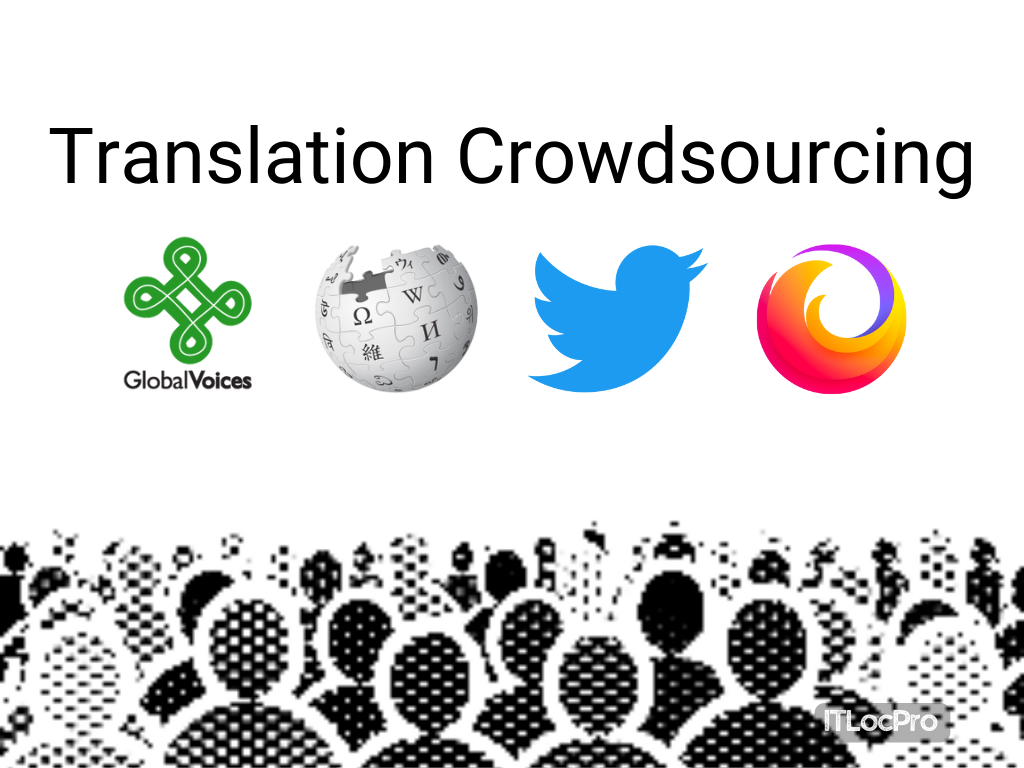
Many for-profit and non-profit organizations and companies, such as Wikipedia, Twitter, Mozilla, Global Voices, Meta, Google, TED, and Translators without Boarders, have built and utilize a translation crowdsourcing community successfully to produce more localized products with more languages. What is translation crowdsourcing? How do they create a community successfully? I will explain this in more detail.
Translation Crowdsourcing?
Crowdsourcing, a compound word that combines “crowd” and “outsourcing”, refers to the process that utilizes the resources of a crowd or a large group, such as knowledge, skill, time, or ideas. Translation crowdsourcing is where organizations or individuals allocate some translation tasks to motivated contributors.
There are some myths about crowdsourcing.
Myth1: Translation crowdsourcing is free or cheaper than traditional translation.
Translation crowdsourcing is seen as cheaper or free because organizations or individuals do not need to hire professional translators. This is partially true. The crowdsource translator cost could be free or cheaper. If the organizations or the individuals hire international professional translators, some work is necessary to assist with labor laws and visas. Translation crowdsourcing does not require such costs. However, to manage translation crowdsourcing, organizations need to invest money for technical engineers who setup and manage the platform and tools; and crowdsourcing project managers who maintain the community. The cost could be same as hiring professional translators.
Myth2: The translation quality is low in translation crowdsourcing.
In Facebook, translation crowdsourcing community members voted on translations created by a translation community and on ones created by a professional translator. The result was that 45% favored the translation community and 55% favored the professional translator. It clearly proves that translation crowdsourcing can provide similar quality to professional translators.
Then why are professional translators still hired? One example would be if contents are not suitable for being translated by non-professional translators. Such contents could be about price, features, and internal information. Medical and lawful documents are confident and require a level of high accuracy.
Contents for Crowdsourcing
Lingotek developed a Content Value Index (CVI) that categorizes the content types. There are three types: Professional, Community, and Automatic. As the diagram of Lingotek indicates, the level of quality is varied by the content type.
Professional
Printed materials, books, and product or service information that might include features, benefits, and prices would require professional translators to create high quality translations.
Community
Wiki, knowledge base, and game subtitles require a moderate level of translation and time.
Machine
Comments, blog posts, User Interfaces, and tweets require real-time translation, but not high accuracy.
Crowdsourcing translation could benefit both communities and machines.
Start Translation Crowdsourcing
There is not a specific way to begin that is applicable to all organizations and individuals. Content types, organization types, and priorities are varied. The process should be customized for each organization. Quantity and quality are two major aspects of creating a successful translation crowdsourcing community.
Quantity
Quantity of translation crowdsourcing depends on the motivation of the contributors. The motivation of contributors may include altruism such as a desire to help communities. It may also include utilitarianism such as to get professional experiences or personal skills. Kerry Patterson, the author of “Change Anything: The New Science of Personal Success” describes personal, social, and structural sources of motivation. Personal motivation might include the desire to improve one’s skills and help others. Social motivation might include that contributors participate in the crowdsourcing community because they are motivated by family or friends. Structural motivation could be that contributors are motivated to receive a community badge and more professional experience for their resume. To motivate the contributors, the translation crowdsourcing community manager needs to maintain some aspects.
The translation crowdsourcing community needs to moderate the required resources of the contributors which include time and skill level. A simple and seamless process reduces required time for contributions. Contributors have less stress using an easy-to-use translation system and a user interface. Support systems and tools are important factors to assist contributors and also to increase the quantity. Pleasure factors such as rewards help to maintain the interest of the contributors.
Many successful translation crowdsourcing communities use translation platforms which manage translators, translation contents, the translation status, etc. The platforms include translation assistance tools. The tools could be machine translation, glossary, and translation memory. For example, Crowdin developed a cloud-based translation management system in which community administrators can setup machine translation, glossary, and a voting process for review. The support system should be a mentor system, Wiki, FAQ pages, and a style guide. Many companies use gamification techniques to motivate people such as a point system and leaderboard. Rewards provide enjoyment and feel rewarding to contributors. Some translation communities provide a budge that people post on their Social Networking Services.
Quality
The required quality level depends on content, priority, and scope. The prioritized subjects could be translation speed, quality, or quantity. Based on the priority, the community administrators can determine the quality level. Specific tools and processes are then selected for the quality level. There are mainly four factors to creating a higher quality translation.
The following are samples of the factors. The factors should be customized based on the priorities of the community.
Automation
- Quality assurance (QA) check
- Notification
Resource
- Machine translation
- Style guide
- Translation memory
- Glossary
- Tutorials
- Translation samples
- Wiki
Skill
- Evaluation/ vetting
- Linguistic
- Subject matter expert knowledge
- Trials
Review
- Voting
- Professional
- Contributors
Crowdsourcing is a useful resource. It needs planning and investing before starting. If the community is managed with the proper process and tools, the translation crowdsourcing would be valuable for both the investors and the contributors.
References
Morris, Mike, “DEBUNKED: THE TOP 8 MYTHS ABOUT CROWDSOURCING”, 2017, https://www.topcoder.com/blog/8-myths-about-crowdsourcing/
transifex, “Getting Started with Crowdsourcing”, 2016, https://www.transifex.com/blog/2016/crowdsourcing-101/
Thicke, Lori, “Expanding reach through crowdsourcing”, 2013, https://multilingual.com/articles/enterprise-innovators-expanding-reach-through-crowdsourcing/
Lingotek, “Machine Translation”, 2016, https://lingotek.com/images/pdf/Lingotek-Translation_Management_System_Product_Brief_08_13_14.pdf
Patterson, Kerry, 2012, “Change Anything: The New Science of Personal Success”
